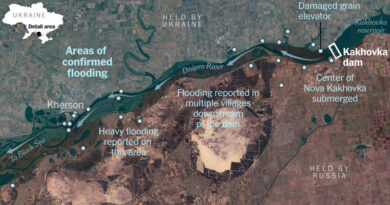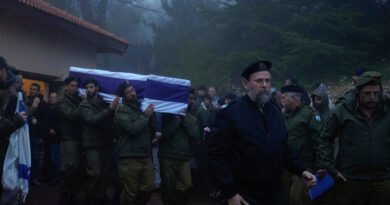Ukraine Attacks Along a 600-Mile Front, While Grappling With Flood Crisis
[ad_1]
Ukrainian and Russian forces clashed along a sprawling, 600-mile front line Saturday, while Ukrainian rescue workers searched fetid floodwaters for survivors even as Russia continued to bombard evacuation points and coastal communities.
The Ukrainian military, which guards battlefield information closely, offered only broad acknowledgment of the clashes playing out along the front Friday night into Saturday. Military analysts said it appeared that Ukraine was trying to break through the Russian lines at several locations in the south and east, near the towns of Orikhiv in the Zaporizhzhia region and Velyka Novosilka in the Donetsk region.
President Volodymyr Zelensky of Ukraine gave the strongest confirmation yet that the long-anticipated Ukrainian counterattack had begun, saying on Saturday that, “counteroffensive and defensive actions are being taken in Ukraine. At what stage, I will not disclose in detail. I believe that we will definitely feel this.”
He made the remarks at a news conference with the Canadian prime minister, Justin Trudeau, who arrived in Kyiv Saturday on an unannounced visit to demonstrate support for Ukraine.
Over the past 24 hours, Ukrainian forces firing rockets and artillery hit four Russian command centers, six areas of concentration of personnel, weapons and military equipment, three ammunition depots and five enemy artillery units in firing positions, Ukraine’s military said. The claims could not be independently verified.
In the ruined eastern city of Bakhmut, Ukrainian forces have advanced by about a mile at some parts of the front line, the military said on Saturday, trying to reclaim a wasteland that Russia spent nearly a year and thousands of soldiers’ lives to capture last month.
The object was to take advantage of a rotation of Russian units in the area, Col. Serhiy Cherevaty, the spokesman for the eastern military command, told local television. He said the Ukrainian military had engaged Russian forces on six occasions near Bakhmut over the past 24 hours.
He did not specify where Ukraine had pressed forward, and his claims could not be independently verified.
The Russian Ministry of Defense claimed it successfully repelled all assaults and had no comment on the situation around Bakhmut.
Russian forces also targeted Ukrainian towns and cities far from the front, firing missiles and drones Friday night at the port city of Odesa. Ukraine’s military said that its air defenses shot down all eight drones aimed at the city, but that debris from the weapons fell onto a nine-story apartment building, killing at least three people and injuring about two dozen others, including a pregnant woman and two children.
The Ukrainian military said that it also shot down two of three missiles targeting the city, but that one had hit the coast, injuring at least three people.
The destruction of the Kakhovka dam on Tuesday unleashed a mighty torrent of water that has torn through dozens of towns and villages across southern Ukraine — leaving thousands homeless, ruining more than a million acres of once rich farmland and threatening to leave hundreds of thousands of people without access to clean drinking water. That has left Ukraine coping with one of the worst ecological and economic disasters in Europe in decades even as it mounts its most ambitious and strategically critical military campaign of the war.
In the city of Kherson the floodwaters were “receding little by little,” Oleksandr Prokudin, the head of the regional military administration, said in a video statement.
About 35 villages and more than 3,700 homes in Ukrainian-controlled territory were still flooded, he said, adding that the situation in Russian-occupied towns and villages in low-lying areas on the eastern bank remained perilous.
At least 27 people in the Ukrainian-controlled part of the Kherson region were missing, Ihor Klymenko, Ukraine’s minister of internal affairs, said in a statement. More than 2,600 people have been evacuated, he said, including 160 children.
Even as rescue efforts were underway, Russian forces shelled settlements in Ukrainian-held parts of the Kherson region 41 times on Friday, he said, injuring at least four people, including a child. The contents of cemeteries in two villages were swept out to sea, he said, adding to the toxic swirl of debris and munitions washing up on shores across southern Ukraine.
In a precautionary move, Ukraine’s nuclear energy agency put into “cold shutdown” the last operating reactor at the Zaporizhzhia nuclear power plant, which relies on water from the reservoir for cooling. The plant is not in immediate danger, the agency, Energoatom, added.
Concern has mounted that the floodwaters could be a breeding ground for disease, but Ukraine’s Health Ministry said that reports on social media about a cholera epidemic were false. The ministry said it would nonetheless step up epidemiological surveillance and increase stocks of necessary medicines in the region.
Bacterial diseases like cholera and dysentery pose a risk to people in the flooded areas, particularly those with limited access to clean water, but the ministry said that for the moment the situation was under control.
The effects of the loss of the reservoir were also being felt outside the flood zone, since it was the primary source of drinking water for hundreds of thousands of people in the region. More than 89,000 customers in the Dnipro area had no water, Ukraine’s Interior Ministry said on Saturday.
While grappling with the immediate humanitarian crisis, Ukrainian officials are trying to assess the long-term consequences of the dam’s destruction, which threatens to leave hundreds of thousands of acres of farmland without adequate irrigation, further ravaging Ukraine’s agricultural industry and deepening a global food crisis.
The Kakhovka irrigation system — the largest in Europe and one of the largest in the world — provided essential water to more than 617,000 acres of farmland in Ukraine’s dry southern steppes. That is now lost, according to a report by Ukraine’s State Agency of Recreation and Fisheries that was released on Friday.
In addition, the report said, water supplies will be cut for irrigation systems that served another 1.2 million acres of farmland that before the invasion allowed for the cultivation of a wide variety of crops, such as corn, soybeans, rapeseed, wheat, eggplant, onions, peppers and cucumbers.
The United Nations’ top aid official, the Under Secretary-General Martin Griffiths, said in an interview on Friday that the long-term consequences of the dam collapse and flooding were “extremely dire” and would affect global food supplies.
Ukraine is a leading grain exporter, and the steep drop in its exports because of the war has led to concerns about food security for millions of people around the world. After the dam collapse this past week, global prices for wheat and corn rose amid fears about Ukraine’s continued ability to grow food for Africa, the Middle East and parts of Asia.
As Ukrainian leaders struggle to get a clear picture of the sprawling humanitarian crisis unfolding in southern Ukraine — an effort complicated by the fact the Russians do no allow independent observers and humanitarian organization operate in territory they control — Moscow and Kyiv were dueling on another front in the war: information and controlling the war’s narrative.
Hanna Maliar, a deputy Ukrainian defense minister, said that war invariably involves losses, including “the most terrible, but inevitable losses” of people’s lives. But she said that “current wars take place in two dimensions — real and informational.”
Some accused the Russians of overstating battlefield successes. The Institute for the Study of War, a Washington-based think-tank, said “the Russian information space prematurely claimed that the Ukrainian counteroffensive has failed after Russian forces damaged more Western-provided Ukrainian military equipment on June 9.”
President Vladimir V. Putin, in rare comments on battlefield developments, said fighting has been ongoing for five days and claimed that Ukrainian forces “did not reach their aims in any area of combat.”
Mr. Putin’s willingness to discuss the counteroffensive “may indicate that the Kremlin is learning from its previous failed approach to rhetorically downplay successful Ukrainian counteroffensives in 2022,” the I.S.W. analysts said.
Ms. Maliar warned that Russia often releases inflated figures in the hopes of extracting valuable information from Ukraine’s efforts to rebut them.
“It is necessary to understand that we also fight with information, just like the enemy,” she said.
Andrew E. Kramer contributed reporting from Zaporizhzhia, Ukraine.
[ad_2]
Source link



